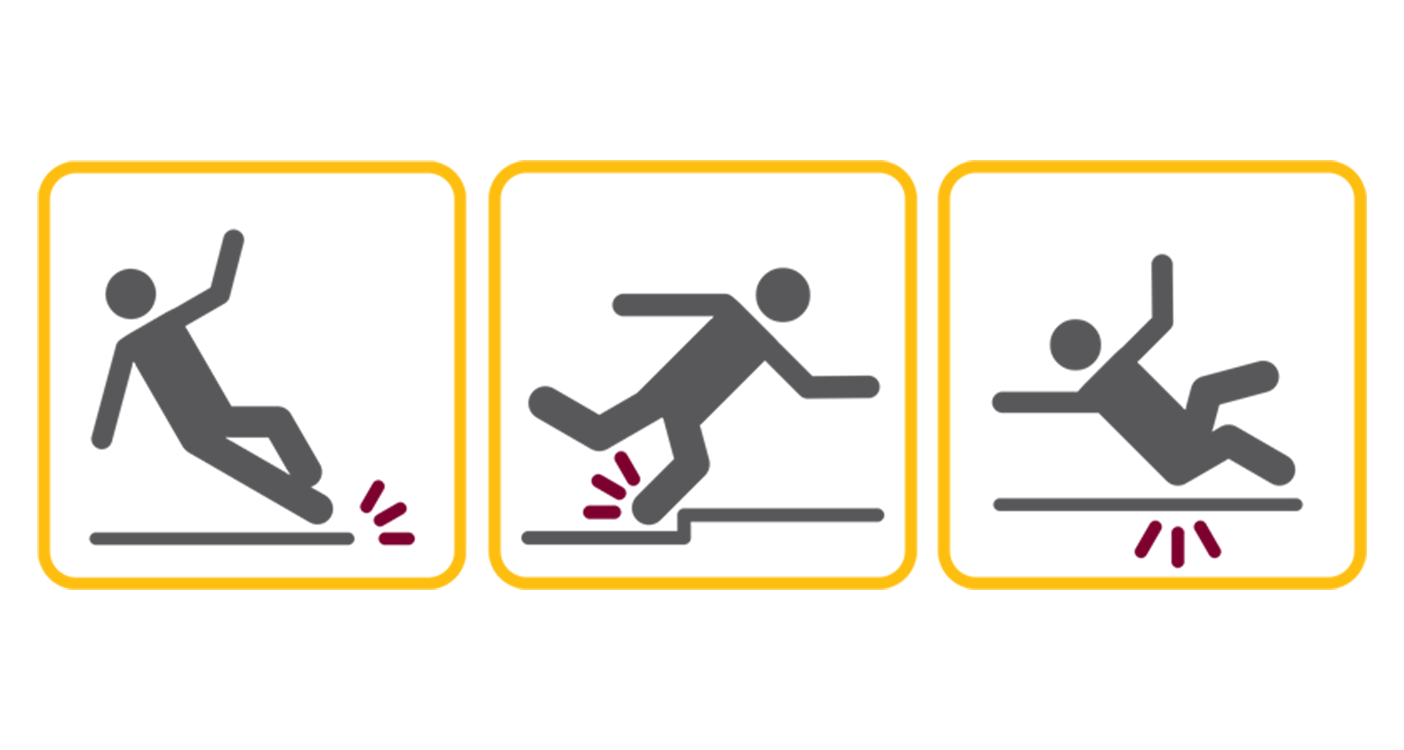|
|
|  | Slips, Trips, and FallsSlip, trip, and fall hazards can be present in many work environments, which can result in serious injuries and time away from work. It’s important that you understand how to recognize and control these hazards to keep you, your colleagues, and the campus community safe.
Overview
-
Slips occur when there is insufficient friction or traction between your feet and the walking surface, resulting in a loss of balance. Common causes of slips include spills, sloped surfaces, improper footwear, and weather-related hazards such as snow, rain, or ice.
-
Trips occur when your foot or leg hits an object, and you have enough momentum to lose balance. Common causes of trips include uncovered electrical cords, cluttered walkways, elevation changes, unsecured carpets and mats, uneven surfaces, and damaged stairs.
-
Falls occur when you are too far off your center of balance. The two basic types are same-level and elevated falls. Same-level falls are most frequent, but elevated falls are more severe. Common causes of falls include improper use of ladders, damaged floor surfaces, loading docks, and unprotected floor holes, pits, and vaults.
Get trained
Ensure you are up-to-date on your biennial Slips, Trips, and Falls training in myHR Learn. | |
|
| Did you know?The leading causes of slip, trip, and fall injuries are wet or slippery surfaces and poor housekeeping. According to the U.S. Bureau of Labor Statistics (BLS), there were over 670,000 workers who suffered injuries from slips, trips, and falls in 2021-2022 that resulted in time away from work, job transfer, or job restriction. During the same timeframe, 35 Northwestern employees reported injuries from slips, trips, or falls on campus. |
|
| Safety Tips
- Inspect your work area for slip, trip, and fall hazards prior to beginning work, and ensure there is adequate lighting
- Report all observed slip, trip, and fall hazards to your supervisor
- Barricade areas with slip, trip, and fall hazards to prevent people from entering the area
- Maintain good housekeeping and avoid clutter, which could pose trip hazards
- Clean up spilled liquids (e.g., coffee) immediately to avoid slip hazards
- Use handrails when you walk up and down stairs
- To eliminate distractions, avoid using portable electronic devices while walking
- Avoid walking on slippery surfaces (e.g., ice, snow) when possible
- In the winter months, wear proper footwear with good traction and insulation, and walk carefully by taking short steps and walking at a slow pace
|
|
| Safety at HomeWhile slips, trips, and falls can occur anywhere, according to the National Safety Council (NSC), they most often occur at home. Keep your family safe from slips, trips, and falls at home by following these safety tips:
- In the winter months, keep exterior walkways clear of ice and snow
- Arrange or remove furniture so there’s plenty of room for walking
- Do not store items on stairways and ensure handrails are present
- Add grab bars near bathtubs and showers
- Ensure elderly family and friends use canes or walkers for stability
|
|
| Do you want to learn more?
- Contact the Environmental Health and Safety (EHS) team at ehs@northwestern.edu.
- View past Spotlight on Safety discussions here.
|
|
|
|
|


